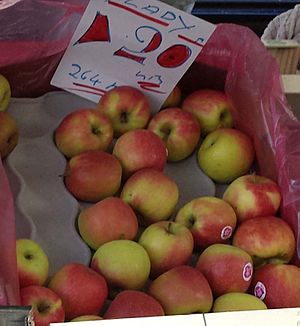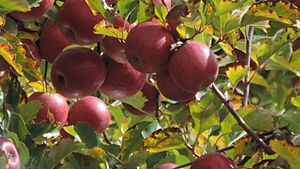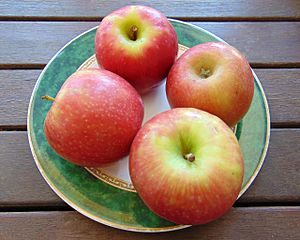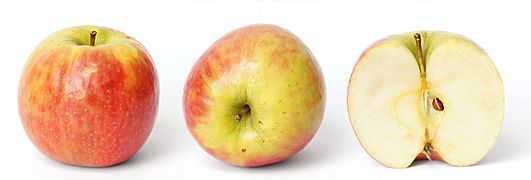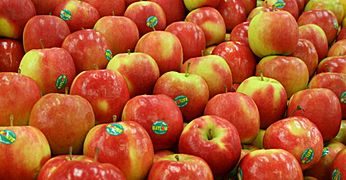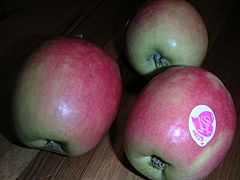Cripps Pink facts for kids
Quick facts for kids Cripps Pink (Pink Lady) |
|
|---|---|
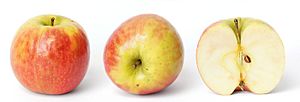 |
|
| Hybrid parentage | Lady Williams × Golden Delicious |
| Cultivar | Cripps Pink |
| Origin | Australia, 1973 |
The Cripps Pink is a special type of apple grown by people. It's one of the apples that can be sold under the famous brand name, Pink Lady. This apple was first created in Australia in 1973 by a person named John Cripps. He mixed two different apples: the Australian Lady Williams apple and the Golden Delicious apple. The Cripps Pink apple gets its firmness and ability to store for a long time from the Lady Williams. It gets its sweetness and doesn't get "storage scald" (a type of damage) from the Golden Delicious.
Contents
What is the Pink Lady Brand?
The Cripps Pink apple was developed by the Department of Agriculture and Food in Western Australia (DAFWA). This department owns the rights to grow and sell this apple in many countries.
The group that represents apple and pear growers in Australia, called Apple and Pear Australia Limited (APAL), manages the "Pink Lady" brand. This brand name is registered in over 80 countries! In the United States and Mexico, another company called Pink Lady America manages the brand.
It was a bit tricky to register the Pink Lady brand in Australia. This is because many people already knew the apple by its brand name, Pink Lady, instead of its official type name, Cripps Pink.
How Pink Lady Apples are Grown
For an apple to be sold as a Pink Lady, it has to meet special quality rules. These rules check things like how much sugar is in the apple, how firm it is, if it has any marks, and its color. People regularly check the apples to make sure they are good quality. They also make sure they can trace where each apple came from, all the way from the farm to the store.
Cripps Pink apples are some of the first apple trees to grow flowers in spring. This happens in late March or early April in places like North America and Europe. In places like Australia, it's late September or early October. They are also some of the last apples to be picked. This happens in late October or early November in the Northern Hemisphere, and late April or early May in the Southern Hemisphere.
The big difference in temperature between night and day in the autumn helps these apples get their beautiful color. But they also need a lot of sunlight. So, farmers have to carefully trim the trees and manage how many apples grow on each tree.
New Types of Cripps Pink Apples
Sometimes, a tree can have a natural change, called a "mutation" or "sport." This means a branch might start growing apples that are a little different from the rest of the tree. Several of these natural changes have been found in Cripps Pink apples. Farmers have started growing these new types too. Many of these new types are also being registered to protect their unique qualities.
Here are a few examples of these new types:
- Rosy Glow: This type was found in Australia in 1995. It's special because its apples get 100% colored, even when other apples nearby are barely colored.
- Lady in Red: This type was found in New Zealand in 1996. Lady in Red apples get their color earlier and have a brighter, more intense red color over more of the apple than regular Cripps Pink apples.
- PLMAS98 (Maslin): Discovered in Australia in 1999, this type ripens and is ready to pick at least 15 days earlier than regular Cripps Pink apples.
- Ruby Pink: Found in Australia in 1999, Ruby Pink apples are a bit more oval-shaped. They also have more red color, are firmer, and ripen later than Cripps Pink apples.
- PLBAR B1 (Barnsby): This type was found in Australia in 1999-2000. It's known for its amazing color and ripens about 14 to 18 days earlier than Cripps Pink.
- PLFOG99 (Pink Belle): Discovered in Australia around 1999-2000, this type produces fruit up to two weeks earlier. The tree also grows in a more compact way.
- Lady Laura: Found in Australia, this type is known for its strong, intense color and gets its color earlier than other Cripps Pink apples.
Many of these improved types, like Rosy Glow, Lady in Red, Maslin, Barnsby, Ruby Pink, and Pink Belle, are now accepted by the Pink Lady brand. This means their apples can also be sold as Pink Lady apples if they meet the quality rules. These new types often have more red color, which is good for farmers. It means more of their apples can be sold. Also, the types that ripen earlier allow apples to be grown in more places without worrying about cold winter weather damaging the crop.
Gallery
See also
 In Spanish: Pink lady para niños
In Spanish: Pink lady para niños


